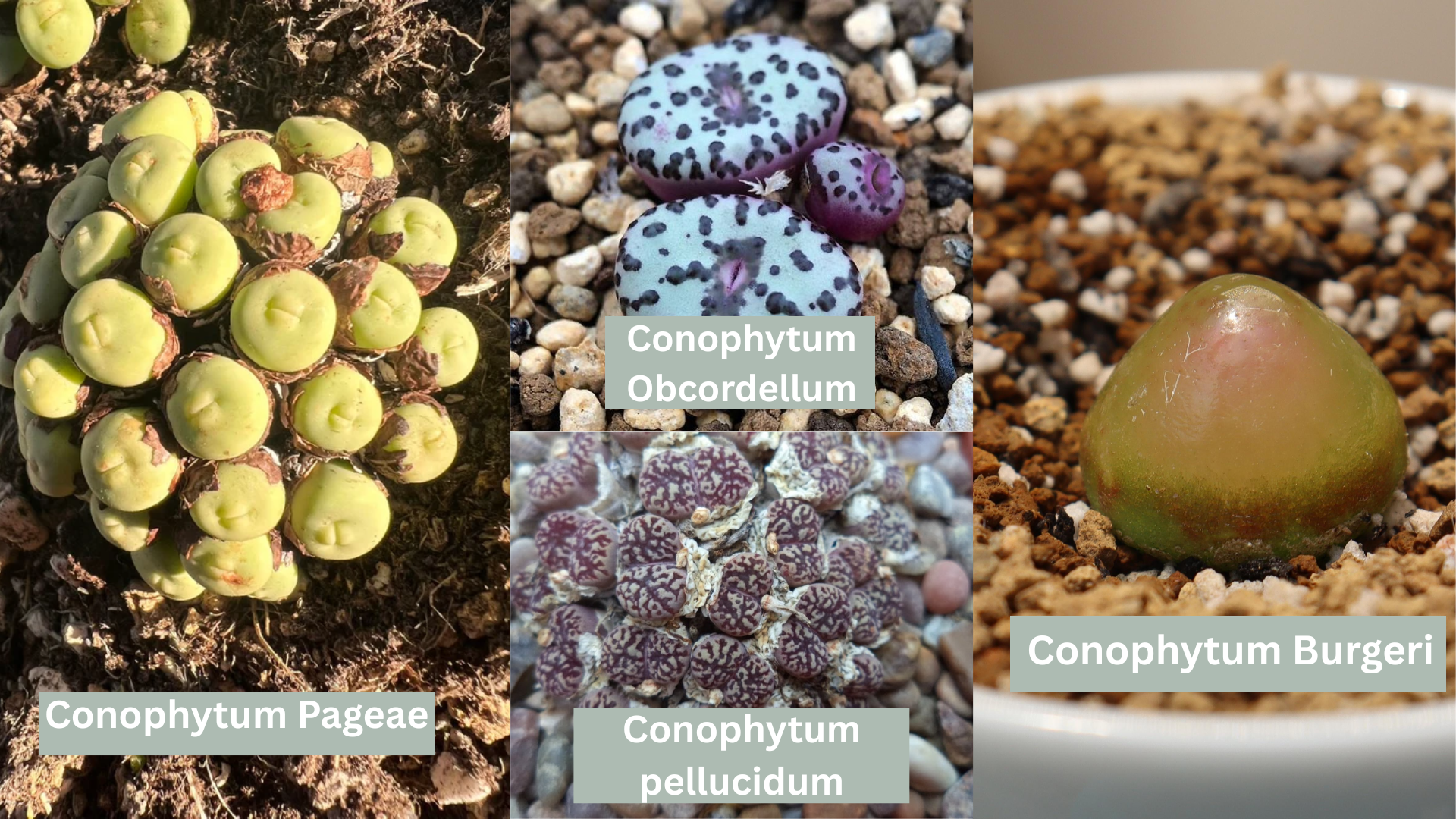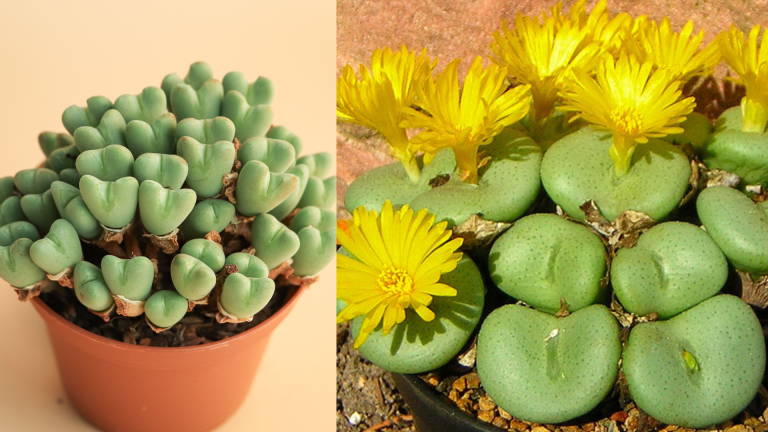Ever seen a plant that looks like a tiny rock? Meet the Conophytum, nature’s master of disguise!
These small succulents might seem boring at first glance, but they’re actually super cool plants with amazing survival skills.
If you’ve struggled to keep plants alive or want something unique for your home, Conophytum could be your perfect green friend.
This blog will explain everything about these interesting plants, from their unique looks to how to care for them.
We’ll see their secret world, share simple tips for growing them, and help you become a Conophytum expert.
What is Conophytum?
Conophytum is a small plant that grows in South Africa and Namibia. These tiny plants have round, fat bodies that look like pebbles. People call them by fun names like “Lips plant,” “Dumplings,” or “Cone plant.”
They grow in dry, rocky areas and can live with very little water. Each plant has one or two thick leaves that join together to form its round shape. They are popular with plant lovers who collect unusual plants.
Types of Conophytum

Conophytum plants come in many types, each with special looks and traits. Here are some common ones you might want to grow at home.
Conophytum Pageae (Lips Plant)
Conophytum pageae got its nickname “Lips Plant” because its split top looks like a pair of lips. This small plant has bluish-green bodies that grow in tight groups.
During fall, it shows off pink or white flowers that pop up from the split. It needs very little water and does well in bright, indirect light. Many home growers like this type because it stays small and flowers easily.
Conophytum Burgeri (Button Plant)
Conophytum burgeri is called “Button Plant” due to its round, button-like shape. It forms small clusters of green to brown bodies. Each plant body is just about the size of a pea.
Its yellow flowers bloom in fall, coming out from a tiny slit on top. This plant grows slowly and needs protection from the hot sun. It works well in small pots on window sills.
Other Notable Species
Many other Conophytum types are worth growing. Conophytum minimum is one of the smallest, with pea-sized bodies. Conophytum obcordellum has heart-shaped tops when seen from above.
Conophytum pellucidum has see-through “windows” on top that let light into the plant. These plants come in various colors, from green to purple and brown, with flowers in white, yellow, pink, or orange.
Conophytum Appearance
Conophytum plants look like tiny, round cones sitting close to the ground. These small succulents come in different colors, from green to reddish-brown. Their bodies are smooth and compact, almost like smooth pebbles.
When they bloom, tiny, delicate flowers pop out from between their cone-shaped parts, adding a splash of color to their simple shape.
Each plant looks like a small, hidden treasure waiting to be noticed in rocky landscapes.
Best Growing Conditions
Growing Conophytum successfully means understanding its unique needs.
These small plants thrive when you mimic their natural habitat, paying close attention to specific care requirements that help them stay healthy and strong.
Light Requirements
Conophytum plants love bright, indirect sunlight that doesn’t burn their delicate bodies. They do best near windows with filtered light, where they can get plenty of sunshine without direct, harsh rays.
During summer, provide some shade to protect them from intense midday sun. In winter, they appreciate more direct light to support their growth cycle and keep them looking vibrant and green.
Temperature and Humidity
These succulents prefer cool to mild temperatures, thriving best between 50-75°F (10-24°C). They handle dry conditions well but appreciate a bit of humidity, around 40-50%.
During winter, they can tolerate slightly cooler temperatures. Avoid placing them near heating vents or in spots with extreme temperature changes that might stress the plants.
Soil and Container Suggestions
Choose special succulent or cactus soil that drains quickly and prevents water from sitting around the roots. These compact plants work best in small, shallow pots.
Terra cotta or clay containers are ideal because they help remove extra moisture. Make sure the pot has drainage holes to keep the roots from sitting in water, which can cause root rot.
Caring for Your Conophytum
Keeping Conophytum plants healthy requires understanding their unique care needs. These special succulents need careful attention to watering, feeding, and seasonal changes.
By following some simple guidelines, you can help your plants thrive and stay strong.
Watering
Conophytum plants need very little water and are easy to overwater. During their active growing season (fall and winter), water sparingly when the soil feels completely dry.
Use a small amount of water to moisten the soil. In summer, they go dormant and need almost no water. Always check the soil before adding any moisture to prevent root rot.
Fertilizing
Feed your Conophytum with a weak, diluted fertilizer made for succulents during its active growing season. From fall to early spring, use a low-nitrogen fertilizer about once a month.
Mix the fertilizer to half the strength recommended on the package. Stop feeding completely during the summer when the plants are resting. This helps keep them healthy without causing stress.
Dormancy
During summer, Conophytum enters a rest period where it looks dried out and inactive. This is totally normal and important for their health. Keep it in a cool, dry spot with minimal water.
Its old leaves will shrink and cover new growth. Don’t worry about its appearance—it’s simply storing energy for the next growing season.
Common Problems and Troubleshooting
Understanding potential issues helps keep Conophytum plants healthy. Catching problems early means saving your plant and preventing long-term damage.
Quick action and careful observation are key to successful succulent care. Some common Conophytum challenges are as follows.
- Dormancy Confusion: Summer makes plants look dead. It’s natural resting time, and new growth stays hidden. True death means a mushy or collapsed plant.
- Watering Problems: Soft spots mean too much water, and wrinkles show too little. Check the soil before watering, and keep it slightly dry.
- Pest Invasion: Mealybugs and spider mites appear as white spots or webs. Isolate plant. Clean with alcohol. Repeat treatment weekly.
- Soil Issues: Use cactus soil with good drainage. Add potholes. Wet soil rots roots. Replace compacted soil quickly.
- Light Stress: Avoid direct sunlight, prevent color loss, find bright, indirect light, and watch for burns or stretching.
Wrapping Up
Growing Conophytum can be a fun and rewarding experience for plant lovers.
These tiny succulents don’t require much care, but they offer something special—a living piece of nature that fits right on your windowsill.
Whether you’re a first-time plant owner or a seasoned gardener, these little plants can bring joy to your home.
Start with one or two Conophytum and watch how they change your space. Learn from their care and enjoy their unique shapes.
Your green adventure starts now!


















